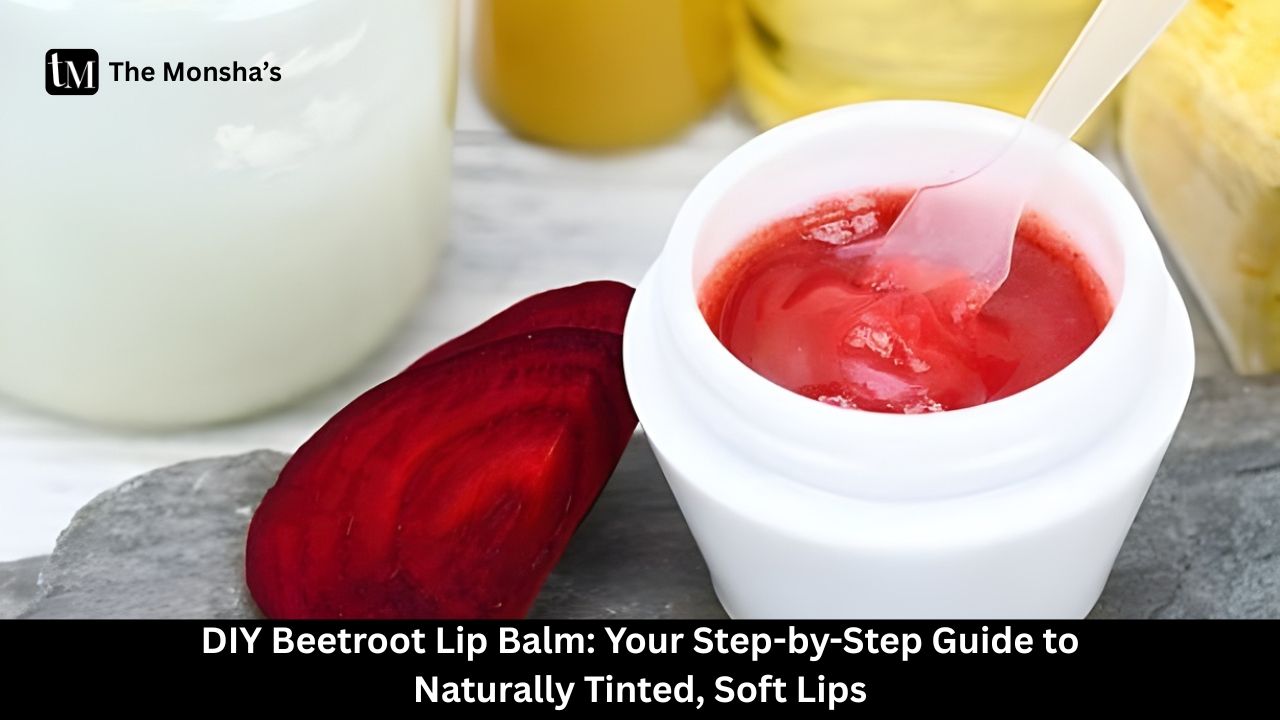TL;DR
A beetroot lip balm is a simple DIY: melt a wax + butter + oil base, add a lip-safe beetroot color source, pour, set. Expect a soft pink tint (not lipstick-level) and comfy moisture. Skip water/juice (preservation issues), go easy on essential oils, and follow derm-backed lip-care rules for lasting results. Glow, but safely.
Why Beetroot for Lips? (The Real Tea) 🍵
Beetroot’s rosy tint comes from betalain pigments (esp. betanin). They’re vivid, but sensitive to heat, light, oxygen, and pH—so how you add color matters. Oil-based, low-heat handling helps keep color stable and prevents that sad brown fade.
Expectation check: beet powders usually give a soft stain in balms (cute, not full-coverage). Many DIYers find the color subtle unless layered.
Desi truth moment: thoda sa rang, zyada sa hydration — that’s the beet balm vibe. ✨
Safety First (Read Before You Melt) 🧯
- No fresh beet juice in balms. Water invites microbes = needs preservatives + emulsifiers = not beginner-friendly. Use dry beet powder or an oil infusion instead.
- Essential oils: use only lip-safe options within IFRA-guided limits (many mints/cinnamons can irritate lips). When in doubt, keep it unscented.
- For chapped lips, derms favor bland, non-irritating balms and thick occlusives (petroleum jelly) to seal moisture. If a balm stings, stop.
What You’ll Need 🧪
Base: beeswax (or candelilla for vegan), a butter (shea/cocoa), and oils (almond, coconut, jojoba, castor).Color: beetroot powder (cosmetic/food-grade, very fine) or beet-infused oil (strain well).Boosters (optional): vitamin E (antioxidant), tiny amount of lip-safe essential oil.Tools: double-boiler setup, glass beaker/bowl, spatula, 0.01 g scale, lip pots/tubes, fine mesh/cheesecloth (for straining).
Ratios That Work (Texture = Everything) ⚖️
Use these starting points; tweak after a small 10 g test batch.

Why these numbers? Tested beeswax-to-oil ranges give predictable firmness/spread; too much wax = draggy, too little = melty.
Step-by-Step Procedure 🧑🍳
1) Make a Beet-Infused Oil (cleanest color)
- Mix 1–2% beet powder into a neutral oil (e.g., jojoba).
- Warm gently (not hot) for 30–45 min; keep covered from light/air; cool.
- Fine-strain (twice) through coffee filter/cheesecloth to remove grit.Why gentle? Heat/light/oxygen degrade betanin; the calmer you keep it, the pinker it stays.
2) Melt the Base
- In a double-boiler, melt beeswax → butters → oils (in that order). Keep heat low.
- Off heat, stir in vitamin E (~0.3%) and your beet-infused oil (part of the total oils).
- Optional: add lip-safe EO at low % (or skip to avoid irritation).
3) Pour & Set
- Pour into sanitized tins/tubes. Tap to release bubbles.
- Let set fully before capping. Label (date/batch).
Will It Actually Help Dry Lips? (Science-backed habits) 🔬
- Seal hydration: occlusives beat fancy scents. If you’re very dry, layer a bland occlusive at night; use tinted beet balm daytime.
- Avoid irritants: some flavors/EOs (peppermint, menthol) can worsen chapping.
- Be gentle with scrubs: lips lack oil glands; over-exfoliation = flakes + sensitivity. If you must exfoliate, do it rarely and mildly, then balm.
Troubleshooting (Because DIY Has A Mood) 🧩
- Gritty feel / specks? You didn’t strain the infusion finely enough—re-melt and re-filter; avoid adding dry powder directly to the molten base unless it’s ultra-micronized.
- Color too faint? Increase infusion strength slightly or add a tiny pinch more powder—but remember betanin’s instability. Layer on lips.
- Too hard / draggy? Drop wax a few percent or add a more slippy oil (castor).
- Oily/melty in heat? Raise wax a touch or add a higher-melt butter.
Thoda jugaad, thoda patience — DIY ka asli mantra. 😉
Shelf Life & Storage 🗓️
- With no water, a beet-oil balm typically lasts several months in a cool, dark place.
- Vitamin E helps slow rancidity (it’s an antioxidant, not a preservative).
- If you ever add water/glycerin, you’re in preservatives territory; keep chilled and expect a short shelf. Beginners should avoid water phases for lip balms.
Sample 10 g Test Formula (Classic Balm) 🧾
- Beeswax: 2.2 g
- Shea butter: 2.5 g
- Jojoba oil (incl. beet-infused portion): 5.1 g
- Vitamin E: 0.03 g (~0.3%)
- Optional lip-safe EO: 0.02–0.05 g (check IFRA limit; or skip)
Melt → stir → pour → set. Test for a week. Adjust wax ±0.3 g for firmness; tweak infusion for tint.
FAQs 🙋♀️
Q1: Can I just squeeze beet juice into my balm?
No. Water invites microbes, needs a real preservative/emulsifier system. Stick to powders or oil infusions.
Q2: Why did my balm turn brownish?
Betanin degrades with heat/light/oxygen. Work low-heat, store in opaque tins.
Q3: My lips sting when I use minty/flavored balms—normal?
Likely irritation. Switch to bland, non-irritating formulas; derms recommend thick occlusives for repair.
Q4: Is beetroot powder safe to ingest from the lips?
Tiny incidental ingestion from a lip cosmetic using food/cosmetic-grade powders is typical, but ensure clean sourcing and avoid additives that aren’t lip-safe. (Color stability, not safety, is usually the bigger DIY issue.)
Q5: Can I make it vegan?
Yes—swap beeswax with candelilla and reduce the amount (it’s harder). Start low and adjust.
Wrap-Up (Glow, But Like… Smart) ✨
Beetroot balms are cute, comfy, and easy when you respect the chemistry: no water, low heat, fine filtration, sane EO limits, and a balanced wax-to-oil ratio. Keep a small test batch, iterate, and listen to your lips. Thoda pyaar, thoda patience — aur lips bolenge, “shaandaar.” 💖

